Page 208 of 360
208 OperationDriving instructionsCrossing obstacles
�
Check the vehicle clearance before
crossing obstacles.
�
Comply with the warnings
(�page 203) and rules for off-road
driving (
�page 204).
�
Select gear range1 on the automatic
transmission (
�page 137).
�
Cross obstacles (e.g. tree stumps or
big rocks) very slowly by aiming one of
the front wheels at the center of the ob-
stacle, and repeat same with the rear
wheel.
!Obstacles can damage the vehicle un-
dercarriage or suspension compo-
nents. If possible use the assistance of
a second person.
After off-road driving or crossing obsta-
cles, inspect vehicle for any damage,
especially vehicle undercarriage and
suspension components. Failure to do
so can adversely affect the vehicle's fu-
ture performance, including increased
chance of an accident.
!Special attention is needed when you
cross obstacles on a steep incline.
The vehicle could slide sideways as a
result of its possible slanted position.
Page 209 of 360
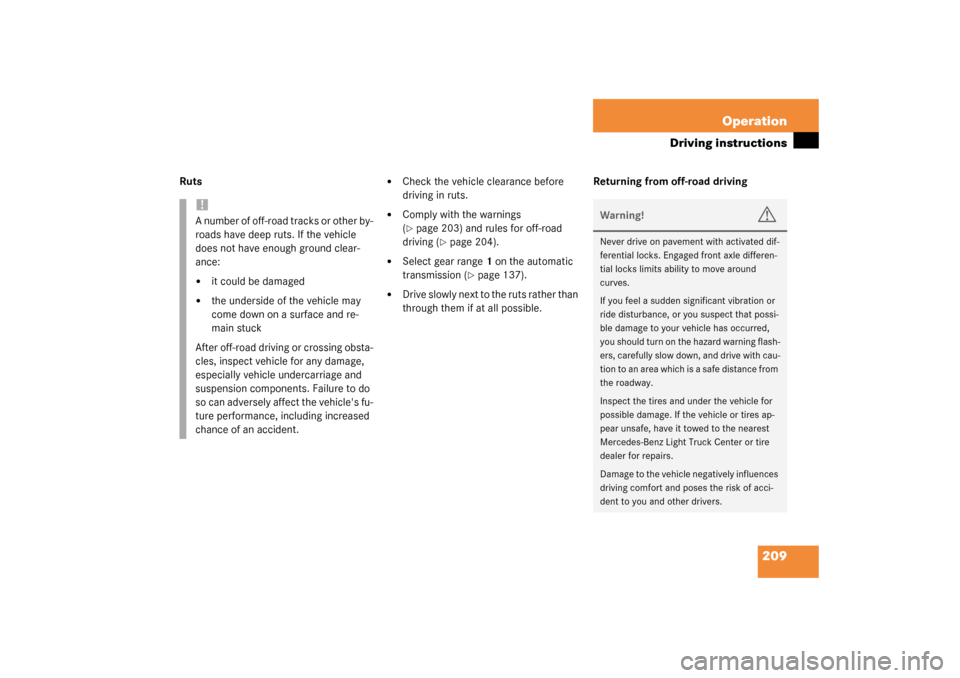
209 Operation
Driving instructions
Ruts
�
Check the vehicle clearance before
driving in ruts.
�
Comply with the warnings
(�page 203) and rules for off-road
driving (
�page 204).
�
Select gear range1 on the automatic
transmission (
�page 137).
�
Drive slowly next to the ruts rather than
through them if at all possible.Returning from off-road driving
!A number of off-road tracks or other by-
roads have deep ruts. If the vehicle
does not have enough ground clear-
ance:�
it could be damaged
�
the underside of the vehicle may
come down on a surface and re-
main stuck
After off-road driving or crossing obsta-
cles, inspect vehicle for any damage,
especially vehicle undercarriage and
suspension components. Failure to do
so can adversely affect the vehicle's fu-
ture performance, including increased
chance of an accident.
Warning!
G
Never drive on pavement with activated dif-
ferential locks. Engaged front axle differen-
tial locks limits ability to move around
curves.
If you feel a sudden significant vibration or
ride disturbance, or you suspect that possi-
ble damage to your vehicle has occurred,
you should turn on the hazard warning flash-
ers, carefully slow down, and drive with cau-
ti o n to a n a r ea wh ic h i s a s a fe dis t an c e f ro m
the roadway.
Inspect the tires and under the vehicle for
possible damage. If the vehicle or tires ap-
pear unsafe, have it towed to the nearest
Mercedes-Benz Light Truck Center or tire
dealer for repairs.
Damage to the vehicle negatively influences
driving comfort and poses the risk of acci-
dent to you and other drivers.
Page 210 of 360
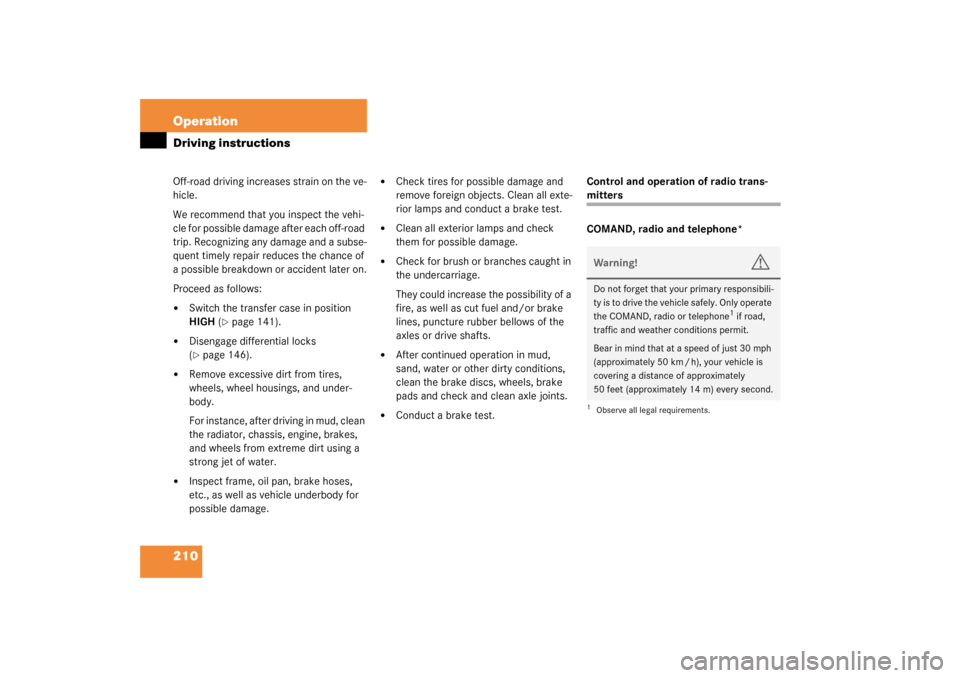
210 OperationDriving instructionsOff-road driving increases strain on the ve-
hicle.
We recommend that you inspect the vehi-
cle for possible damage after each off-road
trip. Recognizing any damage and a subse-
quent timely repair reduces the chance of
a possible breakdown or accident later on.
Proceed as follows:�
Switch the transfer case in position
HIGH (
�page 141).
�
Disengage differential locks
(�page 146).
�
Remove excessive dirt from tires,
wheels, wheel housings, and under-
body.
For instance, after driving in mud, clean
the radiator, chassis, engine, brakes,
and wheels from extreme dirt using a
strong jet of water.
�
Inspect frame, oil pan, brake hoses,
etc., as well as vehicle underbody for
possible damage.
�
Check tires for possible damage and
remove foreign objects. Clean all exte-
rior lamps and conduct a brake test.
�
Clean all exterior lamps and check
them for possible damage.
�
Check for brush or branches caught in
the undercarriage.
They could increase the possibility of a
fire, as well as cut fuel and/or brake
lines, puncture rubber bellows of the
axles or drive shafts.
�
After continued operation in mud,
sand, water or other dirty conditions,
clean the brake discs, wheels, brake
pads and check and clean axle joints.
�
Conduct a brake test.Control and operation of radio trans-
mitters
COMAND, radio and telephone*Warning!
G
Do not forget that your primary responsibili-
ty is to drive the vehicle safely. Only operate
the COMAND, radio or telephone
1 if road,
traffic and weather conditions permit.
Bear in mind that at a speed of just 30 mph
(approximately 50 km / h), your vehicle is
covering a distance of approximately
50 feet (approximately 14 m) every second.
1Observe all legal requirements.
Page 228 of 360
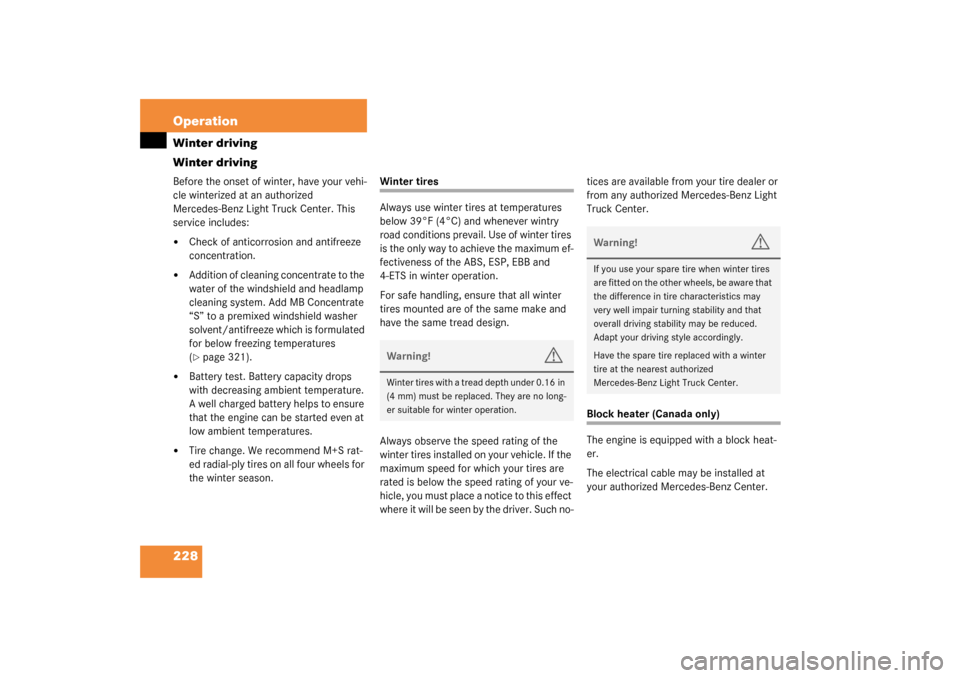
228 OperationWinter driving
Winter drivingBefore the onset of winter, have your vehi-
cle winterized at an authorized
Mercedes-Benz Light Truck Center. This
service includes:�
Check of anticorrosion and antifreeze
concentration.
�
Addition of cleaning concentrate to the
water of the windshield and headlamp
cleaning system. Add MB Concentrate
“S” to a premixed windshield washer
solvent/antifreeze which is formulated
for below freezing temperatures
(�page 321).
�
Battery test. Battery capacity drops
with decreasing ambient temperature.
A well charged battery helps to ensure
that the engine can be started even at
low ambient temperatures.
�
Tire change. We recommend M+S rat-
ed radial-ply tires on all four wheels for
the winter season.
Winter tires
Always use winter tires at temperatures
below 39°F (4°C) and whenever wintry
road conditions prevail. Use of winter tires
is the only way to achieve the maximum ef-
fectiveness of the ABS, ESP, EBB and
4-ETS in winter operation.
For safe handling, ensure that all winter
tires mounted are of the same make and
have the same tread design.
Always observe the speed rating of the
winter tires installed on your vehicle. If the
maximum speed for which your tires are
rated is below the speed rating of your ve-
hicle, you must place a notice to this effect
where it will be seen by the driver. Such no-tices are available from your tire dealer or
from any authorized Mercedes-Benz Light
Truck Center.
Block heater (Canada only)
The engine is equipped with a block heat-
er.
The electrical cable may be installed at
your authorized Mercedes-Benz Center.
Warning!
G
Winter tires with a tread depth under 0.16 in
(4 mm) must be replaced. They are no long-
er suitable for winter operation.
Warning!
G
If you use your spare tire when winter tires
are fitted on the other wheels, be aware that
the difference in tire characteristics may
very well impair turning stability and that
overall driving stability may be reduced.
Adapt your driving style accordingly.
Have the spare tire replaced with a winter
tire at the nearest authorized
Mercedes-Benz Light Truck Center.
Page 229 of 360
229 Operation
Winter driving
Snow chains
Snow chains should only be driven on
snow-covered roads at speeds not to ex-
ceed 30 mph (50 km/h). Remove chains
as soon as possible when driving on roads
without snow. Observe the following guidelines when us-
ing snow chains:
�
Chains cannot be mounted on all
wheel/tire combinations.
�
Chains should only be used on all four
wheels. With only two chains available,
they should be mounted on the rear
wheels. Follow the manufacturer’s
mounting instructions.
�
Use only snow chains that are ap-
proved by Mercedes-Benz. Your autho-
rized Mercedes-Benz Light Truck
Center will be glad to advise you on this
subject.
iWhen driving with snow chains, you
may wish to deactivate the ESP
(�page 76) before setting the vehicle
in motion. This will improve the
vehicle’s traction.
Page 238 of 360
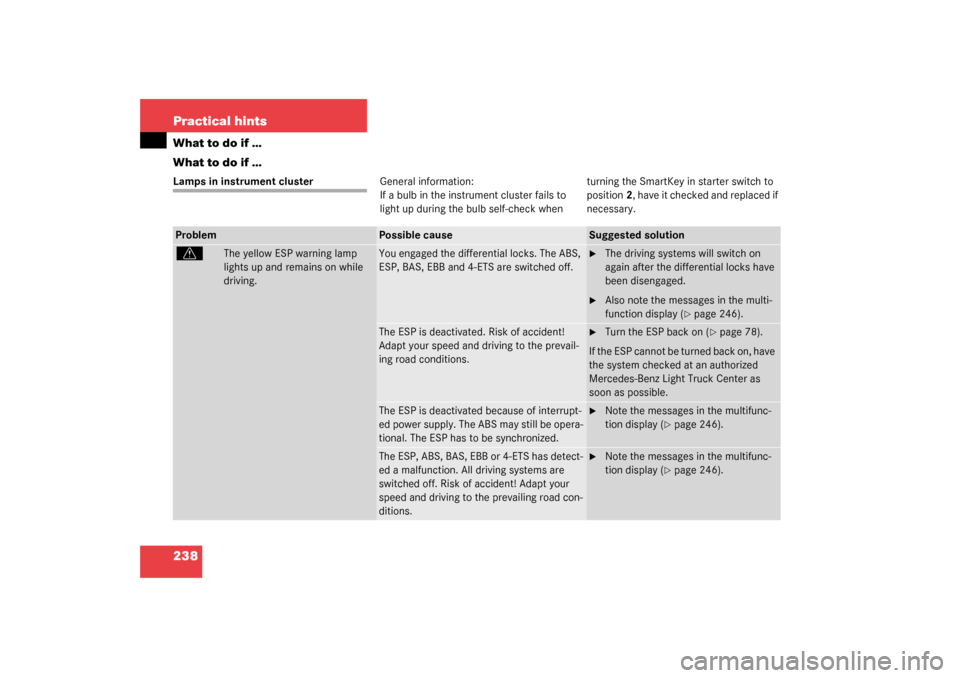
238 Practical hintsWhat to do if …
What to do if …Lamps in instrument clusterGeneral information:
If a bulb in the instrument cluster fails to
light up during the bulb self-check when turning the SmartKey in starter switch to
position2, have it checked and replaced if
necessary.Problem
Possible cause
Suggested solution
v
The yellow ESP warning lamp
lights up and remains on while
driving.
You engaged the differential locks. The ABS,
ESP, BAS, EBB and 4-ETS are switched off.
�
The driving systems will switch on
again after the differential locks have
been disengaged.
�
Also note the messages in the multi-
function display (
�page 246).
The ESP is deactivated. Risk of accident!
Adapt your speed and driving to the prevail-
ing road conditions.
�
Turn the ESP back on (
�page 78).
If the ESP cannot be turned back on, have
the system checked at an authorized
Mercedes-Benz Light Truck Center as
soon as possible.
The ESP is deactivated because of interrupt-
ed power supply. The ABS may still be opera-
tional. The ESP has to be synchronized.
�
Note the messages in the multifunc-
tion display (
�page 246).
The ESP, ABS, BAS, EBB or 4-ETS has detect-
ed a malfunction. All driving systems are
switched off. Risk of accident! Adapt your
speed and driving to the prevailing road con-
ditions.
�
Note the messages in the multifunc-
tion display (
�page 246).
Page 239 of 360
239 Practical hints
What to do if …
v
The yellow ESP warning lamp
flashes while driving.
The ESP or traction control is operating be-
cause of detected traction loss in at least one
tire.
�
During take-off apply as little throttle
as possible.
�
While driving ease up on the accelera-
tor.
�
Adapt your speed and driving to the
prevailing road and weather condi-
tions.
�
Do not deactivate the ESP (excep-
tions: (
�page 76).
Failure to follow these instructions in-
creases the risk of accidents.
Problem
Possible cause
Suggested solution
Page 240 of 360
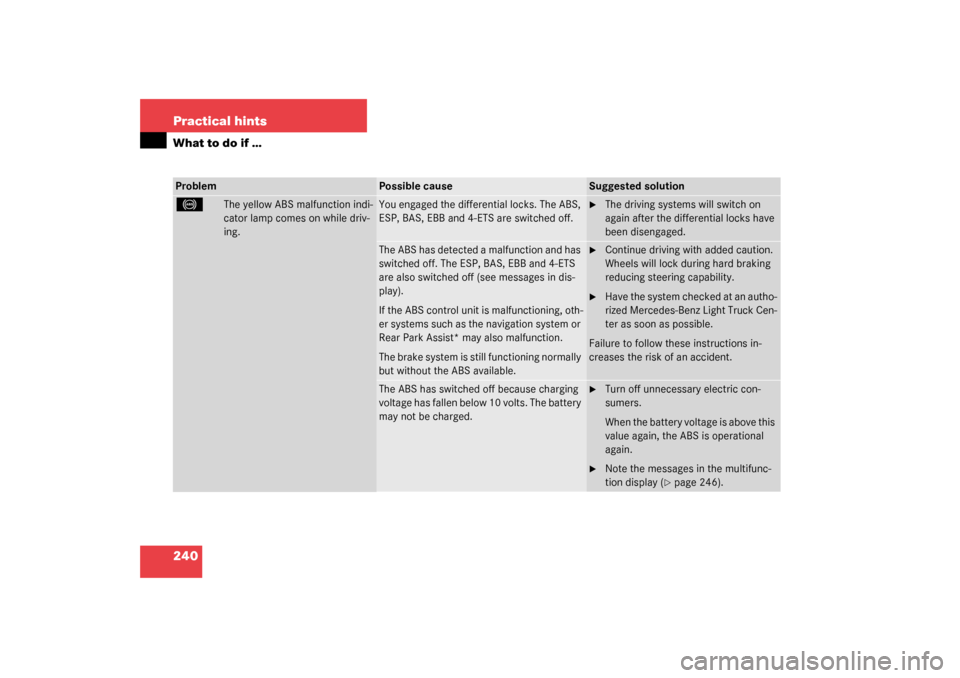
240 Practical hintsWhat to do if …Problem
Possible cause
Suggested solution
-
The yellow ABS malfunction indi-
cator lamp comes on while driv-
ing.
You engaged the differential locks. The ABS,
ESP, BAS, EBB and 4-ETS are switched off.
�
The driving systems will switch on
again after the differential locks have
been disengaged.
The ABS has detected a malfunction and has
switched off. The ESP, BAS, EBB and 4-ETS
are also switched off (see messages in dis-
play).
If the ABS control unit is malfunctioning, oth-
er systems such as the navigation system or
Rear Park Assist* may also malfunction.
The brake system is still functioning normally
but without the ABS available.
�
Continue driving with added caution.
Wheels will lock during hard braking
reducing steering capability.
�
Have the system checked at an autho-
rized Mercedes-Benz Light Truck Cen-
ter as soon as possible.
Failure to follow these instructions in-
creases the risk of an accident.
The ABS has switched off because charging
voltage has fallen below 10 volts. The battery
may not be charged.
�
Turn off unnecessary electric con-
sumers.
When the battery voltage is above this
value again, the ABS is operational
again.
�
Note the messages in the multifunc-
tion display (
�page 246).